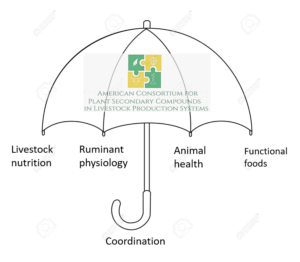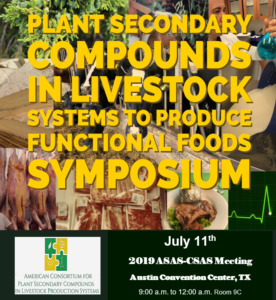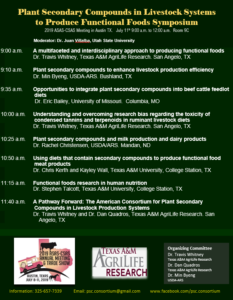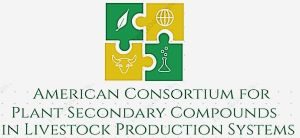Dr. Travis Whitney, Executive Director
Dr. Dan Quadros, Co-Executive Director
The secondary metabolism of the plants produces a large number of specialized compounds that, even though are not directly related to the growth and development of plants, help the plant to survive in its environment. For instance, tannins, saponins, essential oils, organosulphur compounds, flavonoids and some others (oil seeds cakes, agricultural by-products etc.) are plant secondary compounds (PSC) with great potential to be utilized in livestock production systems.
We have scientific evidence that PSC might be a natural way to control internal parasites (i.e. reduce chemicals utilization, costs, and chemical residues in livestock products). Another benefit is to improve nutrition efficiency. For cattle and other ruminants, these compounds may improve protein and energy efficiency in the nutrition process. In this context, the methane emission, a potent GHG responsible for climate change and global warming, from cattle normal enteric fermentation can be reduced that alleviate livestock carbon footprint.
But, moreover, we are currently very interested in studying PSC effects on the nutraceutical and functional properties of milk, meat, and how these products could benefit human health when consumed on a regular basis. Using that approach we organized this event. For us, clearly, PSC have future potential to be used on livestock diets for improving the functionality of animal products (i.e. increasing omega-3). The search for healthy habits and better diets make functional foods attractive to the market. Actually, this market is increasing around the world. The Academic of Nutrition and Dietetics defined functional foods as “whole foods that have a potentially beneficial effect on health.”
In this context, we reunited an outstanding team of scientists in the 2019 American Society of Animal Science/Canadian Society of Animal Science Meeting to present cutting-edge research results in order to overview the state-of-art of PSC knowledge and to open a pathway for the American Consortium for Plant Secondary Compounds in Livestock Production Systems. The consortium will be the cornerstone for future research directions, getting funds and unifying scientific groups and industry efforts. Also, this initiative will converge different areas of PSC studies (e.g. animal nutrition, animal health, animal products quality) in one direction.
Goals
- Synergize fragmented research programs and industry effort
- Reunite an international, interdisciplinary, and multi-institutional team to study PSC in livestock production systems
- Getting funding for R&D
- Create communication channels to strength the outreach of the research groups
- Link research and industry
Structure: The idea is to congregate different areas of knowledge 
under the “umbrella” of the Consortium.
Each segment (livestock nutrition, ruminant physiology, animal health, and functional foods) will be coordinated independently to reunite working subgroups and the current information about the theme to be included in a website. The general coordination of the consortium will be the responsibility of the Executive Director Dr. Travis Whitney and the Co-Executive Director Dr. Dan Quadros, both from Texas A&M AgriLife Research.
Plant Secondary Compounds in Livestock Systems to Produce Functional Foods Symposium
at the 2019 ASAS-CSAS Annual Meeting & Trade Show
July 11, 2019 • Austin, TX
Recap of the symposium available: https://asas.org/taking-stock/blog-post/taking-stock/2019/08/14/plant-secondary-compounds-in-livestock-systems-to-produce-functional-foods-symposium-recap
 |
 |
See the Symposium in the news:
https://agrilifetoday.tamu.edu/2019/07/06/plant-secondary-compounds-in-livestock-systems-to-produce-functional-foods-symposium-set-july-11-in-austin/
https://www.feedstuffs.com/nutrition-health/scientists-share-research-plant-secondary-compounds

